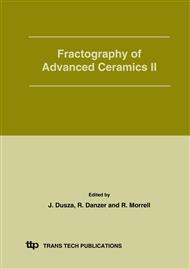p.332
p.336
p.340
p.344
p.348
p.353
p.358
p.366
p.370
Delayed Fatigue of Hydroxy- and Fluorhydroxyapatite Ceramics in Simulated Body Fluid
Abstract:
Ultrafine hydroxyapatite (HA) and fluorhydroxyapatite (FHA) powders were synthesized and dense bioceramic samples were fabricated thereof. The samples were treepoint bend tested in different environments, i.e. in ambient air, distilled water and simulated human saliva, in the wide deformation rate range. Weibull’ statistics test was performed under standard testing conditions but in different media. The stress velocity exponent was evaluated from the dynamic fatigue testing data. The mean strength is shown to decrease when both ceramics are exposed to water or to simulated saliva. HA ceramics is more susceptible to the environment compared to FHA ceramics, due to the later is less subjected to the stress corrosion. Fracture surface observations revealed the crack propagation is of mixed trans- and intergranular mode. Strength distribution changes from uni-modal in air environment to bimodal in harsh conditions of water and saliva, indicating slow increment of flaw size in ceramics. Crack velocity exponent values correspond to transient region from dissociative chemisorption to ion solvation mechanisms of stress corrosion in both HA and FHA ceramics. Generally, FHA ceramics is considered to be much more reliable for application in bone defects replacement or dental reconstruction.
Info:
Periodical:
Pages:
366-369
Citation:
Online since:
July 2005
Authors:
Price:
Сopyright:
© 2005 Trans Tech Publications Ltd. All Rights Reserved
Share:
Citation:


